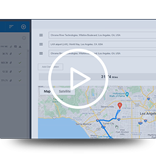Submitting expense claims has long been one of those tasks, like filing taxes, that everyone loves to put off as long as possible - only delaying and worsening the challenge that lies ahead. The longer you wait, the more lines you need to type into the spreadsheet, and the more receipts you need to attach to the printout. Eventually, the need to get the thousands of dollars back into your bank account surpasses your dread, and you spend your weekend hunched over a laptop and a roll of tape.
Related: The Top 10 Perils of Using a Manual Expense Process
Even the introduction of expense management solutions didn’t fully resolve this issue. While solutions made it easier and faster to get images of receipts from the traveller’s wallet to the administrator’s PC, they still left a large number of manual steps at both ends of the process. Customers found them difficult to use and unintuitive.
To counter these challenges, forward-thinking expense solution providers have focused their efforts on improving the customer experience for business travellers, approvers and financial teams alike. Just because submitting expenses is mandatory to be reimbursed doesn’t mean that organisations should have to be stuck with archaic, unintuitive and unfriendly solutions. An expense solution that can humanise the process and reduce the level of frustration at all levels will score big marks for the organisations’ CFOs and CIOs that champion the initiative.
Related: 5 Key Questions to Ask on your Expense Management RFP
Analyst firm Gartner recently released an interesting piece of research that addressed this exact topic, titled How to Improve Employee Expense Management(1). Based on interviews with organisations that have installed expense solutions, it looks at the challenges and frustrations that organisations face in their expense process, and what the executives would like to see done to resolve them. We believe the research note addresses these issues, and also identifies some of the key things that organisations should consider when looking for a new expense management solution. Some of the key findings include:
-
Employee experience is quickly becoming a key design principle for expense management vendors
-
A best-of-breed solution is usually the more appropriate choice for midsize to large organisations, versus an ERP’s expense module
-
Unified payment/card and expense solutions are emerging that can help streamline the expense process, especially for organisations with large numbers of non-employee expenses
Related: Capterra, GetApp Reviews Crown Chrome River as the User Favourite in Expense Management Software
If you’re considering an expense solution - whether you’re looking to move away from a manual, spreadsheet-based solution or are looking to replace your legacy system - this research provides a great overview on what to look for.
-
Gartner, How to Improve Employee Expense Management, Chris Pang, 6 February 2020
Search
Subscribe
Latest Posts
- 9 Signs it’s Time to Switch Expense Management Systems
- Gartner and Ardent Partners Advise How to Build a Best-in-class Accounts Payable Operation
- When Cash (Control) is King: Is Your Accounts Payable Strategy Optimised for a COVID-19 World?
- Getting the Most Out of Your Spend Data with Emburse Insight Advisor
- How We Did It: Supporting Front Line Healthcare Workers During the COVID-19 Outbreak
Posts by Category
Our choice of Chrome River EXPENSE was made in part due to the very user-friendly interface, easy configurability, and the clear commitment to impactful customer service – all aspects in which Chrome River was the clear winner. While Chrome River is not as large as some of the other vendors we considered, we found that to be a benefit and our due diligence showed that it could support us as well as any large players in the space, along with a personalized level of customer care.
We are excited to be able to enforce much more stringent compliance to our expense guidelines and significantly enhance our expense reporting and analytics. By automating these processes, we will be able to free up AP time formerly spent on manual administrative tasks, and enhance the role by being much more strategic.
